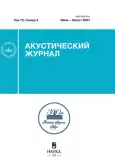Влияние геометрии на распространение изгибной волны в разрезных стержнях
- Авторы: Агафонов А.А.1, Изосимова М.Ю.1, Жостков Р.А.2, Кокшайский А.И.1, Коробов А.И.1, Одина Н.И.1
-
Учреждения:
- Московский государственный университет имени М.В. Ломоносова
- Институт физики Земли им. О.Ю. Шмидта РАН
- Выпуск: Том 70, № 4 (2024)
- Страницы: 469-477
- Раздел: КЛАССИЧЕСКИЕ ПРОБЛЕМЫ ЛИНЕЙНОЙ АКУСТИКИ И ТЕОРИИ ВОЛН
- Статья опубликована: 15.07.2024
- URL: https://gynecology.orscience.ru/0320-7919/article/view/648378
- DOI: https://doi.org/10.31857/S0320791924040019
- EDN: https://elibrary.ru/XGABGF
- ID: 648378
Цитировать
Полный текст
Аннотация
Исследовано распространение изгибных упругих волн в металлических разрезных стрежнях прямоугольного сечения с увеличением глубины прорезей по степенному закону с помощью численного моделирования и экспериментально методом лазерной сканирующей виброметрии. Рассмотрены три типа расположения прорезей: равномерное, учащенное и разреженное к концу стержня. Такие конструкции проявляют свойства акустической черной дыры. В диапазоне частот 10-100 кГц экспериментально обнаружено увеличение амплитуды и уменьшение длины изгибной волны по мере приближения волны к концу стержня для всех исследуемых образцов. Показано, что существует критическая частота, выше которой моды имеют участок с сильно уменьшенным значением амплитуды колебаний.
Полный текст
Об авторах
А. А. Агафонов
Московский государственный университет имени М.В. Ломоносова
Email: aikor42@mail.ru
Россия, Москва
М. Ю. Изосимова
Московский государственный университет имени М.В. Ломоносова
Email: aikor42@mail.ru
Россия, Москва
Р. А. Жостков
Институт физики Земли им. О.Ю. Шмидта РАН
Email: aikor42@mail.ru
Россия, Москва
А. И. Кокшайский
Московский государственный университет имени М.В. Ломоносова
Email: aikor42@mail.ru
Россия, Москва
А. И. Коробов
Московский государственный университет имени М.В. Ломоносова
Автор, ответственный за переписку.
Email: aikor42@mail.ru
Россия, Москва
Н. И. Одина
Московский государственный университет имени М.В. Ломоносова
Email: aikor42@mail.ru
Россия, Москва
Список литературы
- Миронов М.А. Распространение изгибной волны в пластине, толщина которой плавно уменьшается до нуля на конечном интервале // Акуст. журн. 1988. Т. 34. №. 3. C. 546–547.
- Krylov V.V., Shuvalov A.L. Propagation of localised flexural vibrations along plate edges described by a power law // Proc. of the Institute of Acoustics. 2000. V. 22. № 2. P. 263–270.
- Бобровницкий Ю.И., Томилина Т.М. Поглощение звука и метаматериалы (обзор). Акуст. журн. 2018. Т. 64. № 5. С. 517–525.
- Pelat A., Gautiera F., Conlon S.C., Semperlotti F. The acoustic black hole: A review of theory and applications // J. Sound Vib. 2020. V. 476. P. 115316.
- Guasch O., Arnela M., Sánchez-Martín P. Transfer matrices to characterize linear and quadratic acoustic black holes in duct terminations // J. Sound Vib. 2017. V. 395. P. 65–79.
- Krylov V.V. Acoustic Black Holes: Recent Developments in the Theory and Applications // IEEE Trans. Ultrason. Ferroelectr. Freq. Control. 2014. V. 61. № 8. P. 1296–1306.
- Zhao. C., Prasad M.G. Acoustic Black Holes in Structural Design for Vibration and Noise Control // Acoustics. 2019. V. 1. P. 220−251.
- Gao S., Tao Z., Li Y., Pang F. Application research of acoustic black hole in floating raft vibration isolation system // Reviews on Adv. Mat. Science. 2002. V. 61. P. 888−900.
- Агафонов А.А., Коробов А.И., Изосимова М.Ю., Кокшайский А.И., Одина Н.И. Особенности распространения волн Лэмба в клине из АБС пластика с параболическим профилем // Акуст. журн. 2022. Т. 68. № 5. С. 467–474.
- Миронов М.А. Точные решения уравнения поперечных колебаний стержня со специальным законом изменения поперечного сечения // Акуст. журн. 2017. Т. 63. № 5. С. 3–8.
- Миронов М.А. Точные решения уравнения поперечных колебаний стержня со специальным законом изменения поперечного сечения вдоль его оси // IX Всесоюзная акустическая конференция. 1991. Секция Л. С. 23–26.
- Миронов М.А. Разрезной стержень как вибрационная черная дыра // Акуст. журн. 2019. Т. 65. № 6. C. 736–739.
- Агафонов А.А., Изосимова М.Ю., Жостков Р.А., Кокшайский А.И., Коробов А.И., Одина Н.И. Особенности распространения изгибной волны в разрезном стержне // Акуст. журн. 2024. Т. 70. № 3. С. 3–12.
Дополнительные файлы

















